Radiodrome
In geometry, a radiodrome is the pursuit curve followed by a point that is pursuing another linearly-moving point. The term is derived from the Greek words "ῥάδιος" (easier) and "δρόμος" (running). The classic (and best-known) form of a radiodrome is known as the "dog curve"; this is the path a dog follows when it swims across a stream with a current after food it has spotted on the other side. Because the dog drifts downwards with the current, it will have to change its heading; it will also have to swim further than if it had computed the optimal heading. This case was described by Pierre Bouguer in 1732.
A radiodrome may alternatively be described as the path a dog follows when chasing a hare, assuming that the hare runs in a straight line at a constant velocity. It is illustrated by the following figure:

Mathematical analysis
Introduce a coordinate system with origin at the position of the dog at time zero and with y-axis in the direction the hare is running with the constant speed . The position of the hare at time zero is (Ax, Ay) and at time t it is
|
|
(1) |
The dog runs with the constant speed towards the instantaneous position of the hare.
The differential equation corresponding to the movement of the dog, (x(t), y(t)), is consequently
|
|
(2) |
|
|
(3) |
It is possible to obtain a closed-form analytic expression y=f(x) for the motion of the dog, From (2) and (3) it follows that
|
|
(4) |
Multiplying both sides with and taking the derivative with respect to x using that
|
|
(5) |
one gets
|
|
(6) |
or
|
|
(7) |
From this relation it follows that
|
|
(8) |
where B is the constant of integration determined by the initial value of y' at time zero, y' (0)= sinh(B − (Vt /Vd) lnAx), i.e.,
|
|
(9) |
From (8) and (9) it follows after some computations that
|
|
(10) |
If, now, Vt ≠ Vd, this relation integrates to
|
|
(11) |
where C is the constant of integration.
If Vt = Vd, one gets instead
|
|
(12) |
If Vt < Vd, it follows from (11) that
|
|
(13) |
In the case illustrated in the figure above, Vt ⁄Vd = 1⁄1.2 and the chase starts with the hare at position (Ax, −0.6 Ax) which means that y'(0) = −0.6. From (13) it thus follows that the hare is caught at position (Ax, 1.21688Ax), and consequently that the hare will have run the total distance (1.21688 + 0.6) Ax before being caught. The arclength of the dog's path is (13) multiplied by Vd ⁄Vt =1.2 .
If Vt ≥ Vd, one has from (11) and (12) that , which means that the hare will never be caught, whenever the chase starts.
See also
References
- Nahin, Paul J. (2012), Princeton University Press, ed., Chases and Escapes. The Mathematics of Pursuits and Evasion, Princeton, ISBN 978-0-691-12514-5 .
- Gomes Teixera, Francisco (1909), Imprensa da universidade, ed., Traité des Courbes Spéciales Remarquables, 2, Coimbra, p. 255